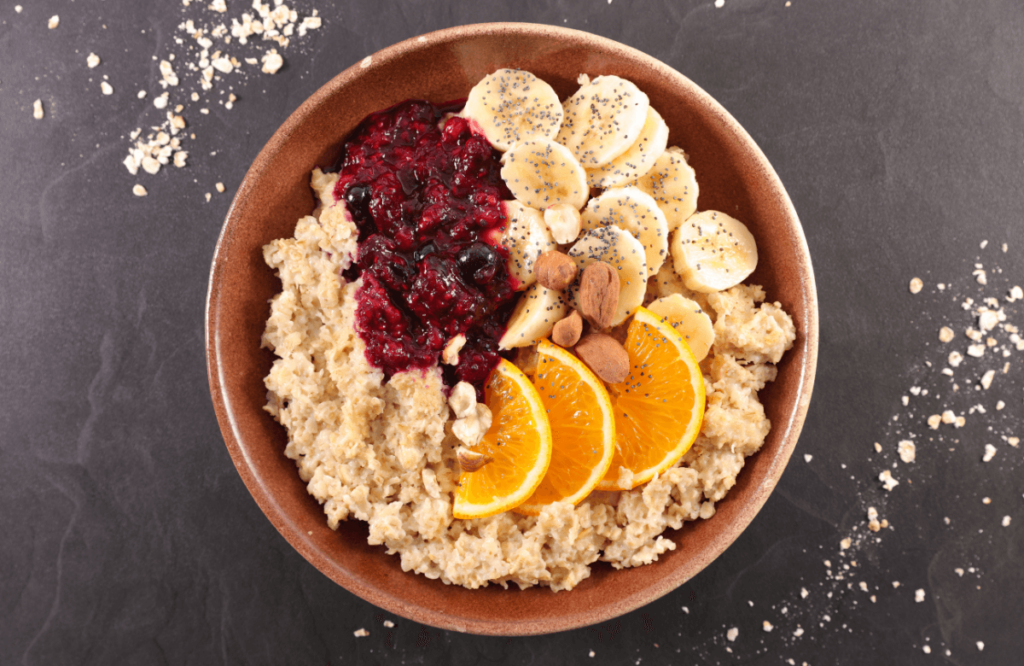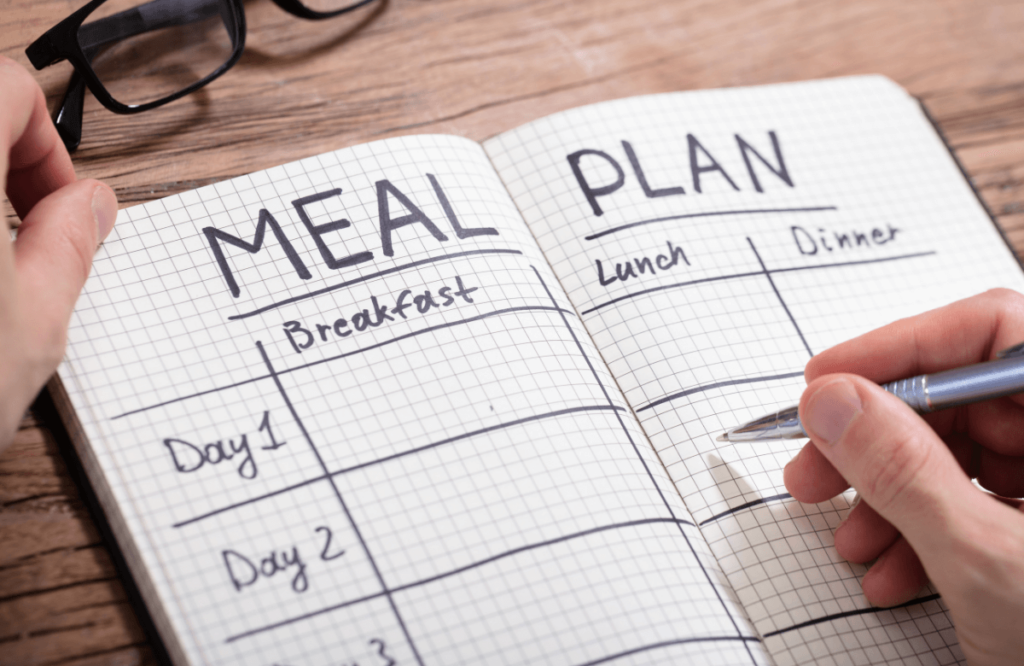Tired of the flab that comes with bulking? Discover lean bulking – the targeted way to build muscle while keeping fat gains minimal.
This powerful diet approach means you can sculpt a leaner, more defined physique. Ready to transform your body?
Here’s the inside scoop on meal planning to fuel your muscle-building goals…and the benefits that go beyond the mirror.
Jump to:
What Is And Why Should You Lean Bulk?
Lean bulking is consuming a caloric surplus to provide the energy and nutrients needed for muscle growth, without excess fat gain. This approach differs from traditional bulking, which often leads to significant fat accumulation. By attempting a lean bulk meal plan, you can optimize your body composition and achieve a sculpted, muscular physique.
As stated above, lean bulking varies from regular bulking. Traditional bulking maximizes muscle gain with the understanding that some fat gain is going to happen. This means it can take a long time to burn off that excess fat when you’re done bulking. Whereas lean bulking is a less aggressive approach where you gain muscle at a slower rate than a full-blown bulk (preventing the accumulation of body fat) and your body stays leaner year-round. By lean bulk planning, you can help get shredded faster when you decide to cut and in return spend less time cutting and assisting in maintaining muscle.
So in conclusion a lean bulk meal plan is a diet where you can gain muscle while minimizing fat gain and if that’s what you’re looking for then lean bulking could very well be for you.

Benefits Of Lean Bulking
There are so many benefits to being in the bulking phase like giving your extra energy for workouts and helping put on pounds of muscle or simply just help you reach your maintenance calories. However, some of our favorite benefits include:
Muscle Gains And Muscle Recovery
Lean bulk meal planning provides the body with the necessary nutrients, particularly protein, to support muscle repair and growth. By consuming an adequate amount of protein in your meals, you create an environment conducive to building lean muscle mass.
Controlled Fat Gain
Unlike traditional bulking, which often leads to excessive fat accumulation, lean bulk meal planning focuses on a slight caloric surplus. This approach helps minimize fat gain while still providing the energy needed for muscle growth. By carefully managing your calorie intake, you can achieve a more balanced and aesthetically pleasing physique.
Improved Body Composition
Lean bulk meal planning allows for simultaneous muscle gain and fat loss. By optimizing your macronutrient ratios and ensuring a balanced diet, you can promote muscle development while keeping unwanted body fat in check. This approach helps sculpt a leaner and more defined physique.

Downsides Of Lean Bulking
Just as there is with anything, there are downsides to lean bulking, and before you change your diet plan it’s a good idea to consider the negative parts of this diet and what it’ll be like eating excessive amounts of food every day for a long period. Here are some downsides to think about:
Requires Lots Of Time
Lean bulk meal planning involves tracking your calorie and macronutrient intake to ensure you’re meeting your specific goals. This kind of clean bulking can be extremely time-consuming and require diligent attention to detail, including weighing and measuring food portions properly. It may not be suitable for individuals who find tracking or meticulous planning too difficult.
Might Not Work For Your Body
Each person’s body responds differently to caloric intake and macronutrient ratios. While lean bulk meal planning provides general guidelines, it may take some trial and error to find the optimal approach for your body, meaning adjustments in calorie intake, macronutrient ratios, and food choices may be necessary to achieve desired results.
It Can Be A Slow Progress
Lean bulk meal planning aims for a slight caloric surplus, which may lead to slower muscle gains compared to more aggressive bulking approaches. This can be frustrating for individuals seeking rapid increases in lean muscle gains and strength. However, it’s important to remember that a slower journey can lead to more sustainable and long-lasting results.
Requires Discipline
Building lean muscle mass takes time and consistency. Planning a lean bulking diet requires discipline to adhere to your meal plan, including portion control, selecting nutrient-dense foods, and avoiding junk food. Patience is also necessary as the progress may be gradual rather than immediate when adding healthy food to your diet and avoiding gaining extra weight. With that said, it’s essential to stay committed and trust the process.

How to Create a Bulking Diet Plan
When creating a lean bulking meal plan it’s important to remember to provide a variety of nutrient-dense foods, including lean proteins, complex carbohydrates, healthy fats, and lots of fruits and vegetables. With this in mind, consider the following tips:
- Prioritize lean protein sources such as chicken breast, turkey, fish, lean beef, eggs, and plant-based options like tofu and legumes.
- Aim for complex carbohydrates like whole grains, quinoa, sweet potatoes, brown rice, and oats, which provide sustained energy and fiber instead of regular potatoes or white rice.
- Incorporate healthy fats from sources like avocados, nuts, seeds, olive oil, and fatty fish for their omega-3 fatty acids and other essential nutrients.
- Load up on fruits and vegetables to meet your micronutrient needs, boost digestion, and support overall health and recovery.
Make Sure To Have A Proper Calorie Surplus
The key to lean bulking is eating 10-20% more calories than you burn. This is enough calories to gain muscle, but not so much that you gain excess fat. For example, an average-sized, 175-pound man would add approximately 250–500 calories, while an average-sized, 135-pound woman would add about 200–400 calories. Next, distribute your macronutrients as follows:
Protein:
Consume approximately 1.2-1.5 grams of protein per pound of body weight to promote muscle repair and growth.
Carbohydrates:
Allocate around 45-55% of your total calories to carbohydrates, emphasizing complex carbs for sustained energy.
Fats:
Include healthy fats comprising around 20-30% of your total caloric intake to support hormone production and overall health.

Lean Bulk Food Choices
Some lean protein sources include chicken breast, turkey breast, fish (such as salmon, tuna, or cod, lean cuts of beef (like sirloin or tenderloin), eggs (egg whites included), greek yogurt (low-fat or non-fat), cottage cheese (low-fat or non-fat), tofu or tempeh, and legumes (such as lentils, chickpeas, and black beans).
Carbs:
If you’re looking for a lean source of complex carbohydrates then whole grains (such as brown rice, quinoa, oats, and whole wheat bread), sweet potatoes, whole wheat pasta, barley, wild rice, or options like rice cakes are a great choice of healthy carbs during the bulk phase.
Healthy Fats:
For healthy fat foods, you’re going to want avocado, nuts (like almonds, walnuts, and cashews), seeds (such as chia seeds, flaxseeds, and pumpkin seeds), olive oil, or coconut oil. Nut butters are also a great form of fatty foods to add for your fat intake.
Fruits/Vegetables:
As for fruits and vegetables, you can do food choices like berries (i.e. blueberries, strawberries, and raspberries), leafy greens (such as spinach, kale, and Swiss chard), cruciferous vegetables (like broccoli, cauliflower, and brussels sprouts), bell peppers, tomatoes, citrus fruits (such as oranges, grapefruits, and lemons), apples, and bananas.
Dairy products / Plant based alternatives:
Some dairy or plant-based alternatives can be things like low-fat or non-fat milk, unsweetened almond milk or other plant-based milk, low-fat or non-fat cheese (like mozzarella or feta), low-fat or non-fat Greek yogurt, plant-based yogurt alternatives (soy or almond-based).
Hydratation:
Your hydration needs will consist of lots of water, herbal teas like green tea or chamomile tea, and fruit or herb-infused water and will fluctuate depending on your activity level.

How To Structure Your Meal Plan
Now, depending on how many rest days you have scheduled, your goal for calories per day, your body size, and your current body weight, it will depend on how much you need to eat. However, we’ve created a six-meal lean bulk diet plan as an example to help make things a little easier when creating your own plan to increase the ratio of muscle and keep off excess weight.
Meal 1:
- Scrambled eggs (3 egg whites, 1 whole egg)
- Whole wheat toast (2 slices)
- Spinach or other leafy greens
- 1 small apple
Meal 2:
- Grilled double chicken breast (4-6 ounces)
- Quinoa (1/2 cup)
- Steamed broccoli
- Mixed greens salad with olive oil and vinegar dressing
Meal 3 (before the workout):
- Whole wheat wrap with turkey breast slices
- Avocado slices
- Mixed vegetables (bell peppers, cucumber, carrots)
- Greek yogurt (non-fat) with berries
Meal 4 (after the workout):
- Whey protein powder mixed with water or almond milk
- A banana or other fruit
Meal 5:
- Grilled salmon (4-6 ounces)
- Brown rice (1/2 cup)
- Steamed asparagus or green beans
- Side salad with mixed vegetables
Meal 6:
- Lean ground beef or turkey or steak with olive oil (4-6 ounces)
- Sweet potato (medium-sized)
- Sautéed zucchini and bell peppers
Snacks (spread throughout the day):
- Almonds or mixed nuts (handful)
- Greek yogurt (non-fat) with a drizzle of honey
- Cottage cheese with fruit
- Protein shake or protein bar (if needed)
There’s technically no need to have exactly six meals per day, but it can certainly help with daily protein distribution when consuming so much high-quality protein.

Meal Timing For Bulking
To optimize muscle growth and recovery consider these strategies:
- Before your workout consume a balanced meal 1-2 hours before exercising that will consist of protein and complex carbohydrates to give you extra energy and fuel your workout.
- Eat a protein-rich meal or shake within 30-60 minutes after your workout to kickstart muscle repair and growth.
- Spread your remaining meals evenly throughout the day to maintain a steady supply of nutrients and support anabolism.
Sometimes getting to the proper daily calorie intake can be hard in bulk, especially for people who burn calories easily and are naturally skinny. If you’re struggling to pack on size, consider smaller, more frequent meals so it doesn’t feel like you’re having to down a buffet at each sitting. Or if intermittent fasting feels better, eat more later in the day and in larger sittings. This really just comes down to personal preference.
How Long Does It Take to Gain Weight and Muscle When Bulking?
Generally, you should be gaining 1/2 lb to 1 lb each week when bulking, though some people might not see results right away or plateau somewhere in the middle or end. If this is the case, it’s recommended to adjust your daily carbs or your form of fat content to help see a difference. It’s also advised to only do this diet for a set period of time which is usually 4-6 months. This means you should see results almost right away and if you don’t you need to adjust your diet.













